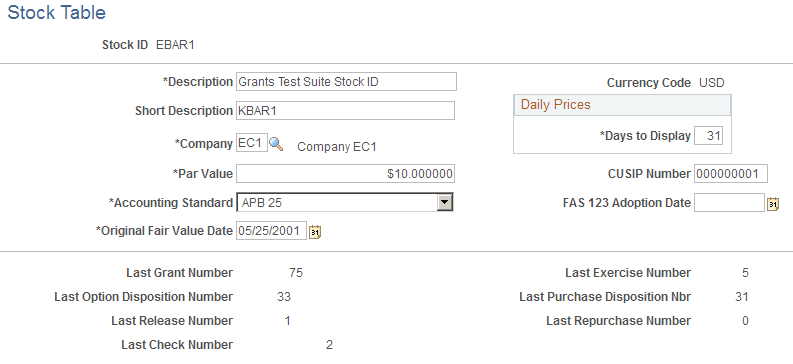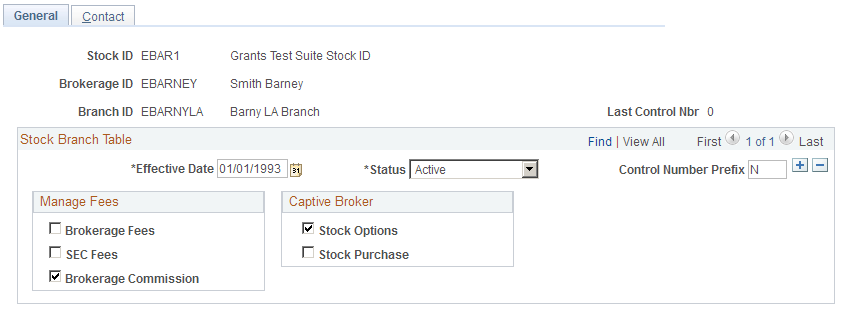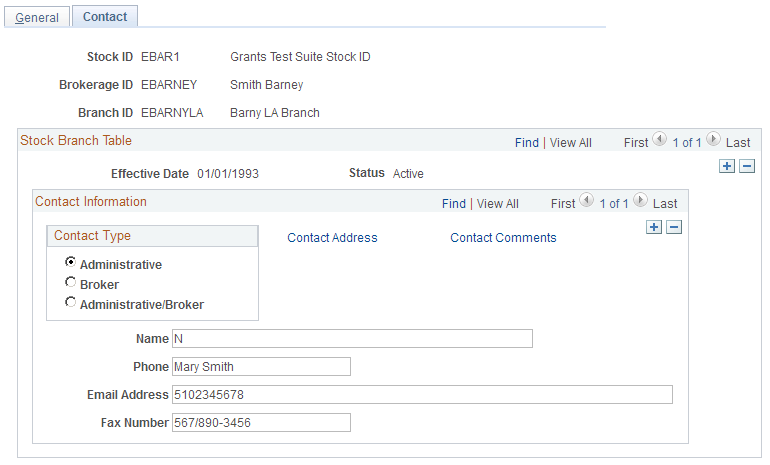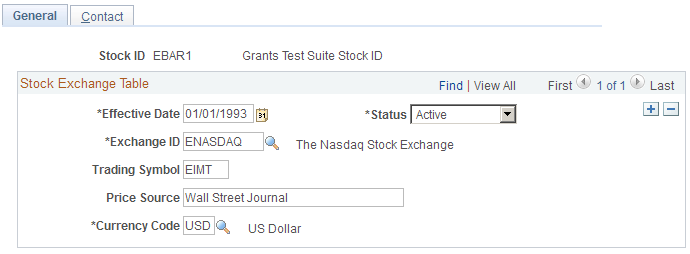Setting Up Stock Rules
To set up stock rules, use the Stock Table (STOCK_TBL), Stock Agent Table (STOCK_AGENT), Stock Branch Table (STOCK_BRANCH), and the Stock Exchange Table (STOCK_EXCHANGE) components.
This topic provides an overview of stock rules and discusses how to set up stock rules.
|
Page Name |
Definition Name |
Usage |
|---|---|---|
|
STOCK_TBL |
Create a unique stock ID that identifies a stock. |
|
|
STOCK_AGENT |
Link escrow and transfer agencies that provide service for your stock with a stock ID, and add contact information. |
|
|
STOCK_BRANCH1 |
Link brokerage branches to stock IDs, and define fee options and captive broker authorization. |
|
|
STOCK_BRANCH2 |
Define brokerage branch contacts. |
|
|
STOCK_EXCHANGE1 |
Link a stock ID with a stock exchange and define exchange details. |
|
|
Stock Exchange Table - Contact Page |
STOCK_EXCHANGE2 |
Define stock exchange contacts. |
After you set up foundation tables, create a key identifier for your company's stock and add default values for your stock plans, including the stock's par value, CUSIP number, and the accounting standard for valuing stock options and purchases. You can override some of these values at the plan level to accommodate special circumstances or at the stock detail level as the profile of your stock changes over time. For instance, your stock exchange and symbol might change, but the key identifier remains the same.
Reports that are relevant to the tasks that are discussed in this section are:
Stock Agent report (STSU017)
Stock Branch report (STSU018)
Use the Stock Table page (STOCK_TBL) to create a unique stock ID that identifies a stock.
Navigation
Image: Stock Table page
This example illustrates the Stock Table page.

|
Field or Control |
Definition |
|---|---|
| Par Value |
Enter the stock's par value. This is informational only. |
| CUSIP Number |
Enter the stock's CUSIP number. |
| Accounting Standard |
Select the financial accounting standard that your organization has adopted for valuing stock options and stock purchases. Values are: FAS 123 and APB 25. |
| FAS 123 Adoption Date |
If applicable, enter the date your organization adopted FAS 123. |
| Original Fair Value Date |
Enter the date your company either adopted the expense recognition requirements of FAS 123 or began to disclose the proforma impact of FAS 123. If you selected FAS 123 as the accounting standard, enter the first day of your company's first fiscal year after 12/15/1995. If you selected APB 25 enter the first day of your company's first fiscal year after 12/15/1994. Note: When you run the Valuation Audit report, the system identifies all grants issued after this date that do not have a valuation record. |
| Days to Display |
Enter the number of days that you want to display on the Maintain Daily Prices page. |
Displayed Tracking Numbers
These tracking numbers (Last Grant Number, Last Exercise Number, and so on) are display-only and are continuously updated to reflect transactions processed by Stock Administration. The numbers start at 0 (zero) for each new stock ID.
Use the Stock Agent Table page (STOCK_AGENT) to link escrow and transfer agencies that provide service for your stock with a stock ID, and add contact information.
Navigation
|
Field or Control |
Definition |
|---|---|
| Agency Type |
Select Escrow if the agency provides only escrow services, Transfer if the agency provides only transfer services, or Escrow/Transfer if the agency provides both services. |
Use the Stock Branch Table - General page (STOCK_BRANCH1) to link brokerage branches to stock IDs, and define fee options and captive broker authorization.
Navigation
Image: Stock Branch Table - General page
This example illustrates the Stock Branch Table - General page.

|
Field or Control |
Definition |
|---|---|
| Last Control Nbr |
This field displays the last control number used for this branch. |
| Control Number Prefix |
Enter a prefix to associate with a last control number. The system will generate a sequential number with the prefix that you enter. For example, you may want to enter 2000 to identify the last control numbers from calendar year 2000. This field is optional. |
Manage Fees
Select the fee fields to enable on the Exercise Sales and Release Sales pages. You may select more than one.
Captive Broker
|
Field or Control |
Definition |
|---|---|
| Stock Options and Stock Purchase |
Select to designate the authorized brokerage for stock option plans and for stock purchase plans, respectively. |
Use the Stock Branch Table - Contact page (STOCK_BRANCH2) to define brokerage branch contacts.
Navigation
Image: Stock Branch Table - Contact page
This example illustrates the Stock Branch Table - Contact page.

|
Field or Control |
Definition |
|---|---|
| Contact Type |
Values are: Administrative, Broker, or Administrative/Broker. You can identify one person or different people to serve as the administrative and broker contact. |
Use the Stock Exchange Table - General page (STOCK_EXCHANGE1) to link a stock ID with a stock exchange and define exchange details.
Navigation
Image: Stock Exchange Table - General page
This example illustrates the Stock Exchange Table - General page.

|
Field or Control |
Definition |
|---|---|
| Trading Symbol |
Enter the stock's trading symbol. |
| Price Source |
Enter the source used to report and track daily prices. This field is for information only. |